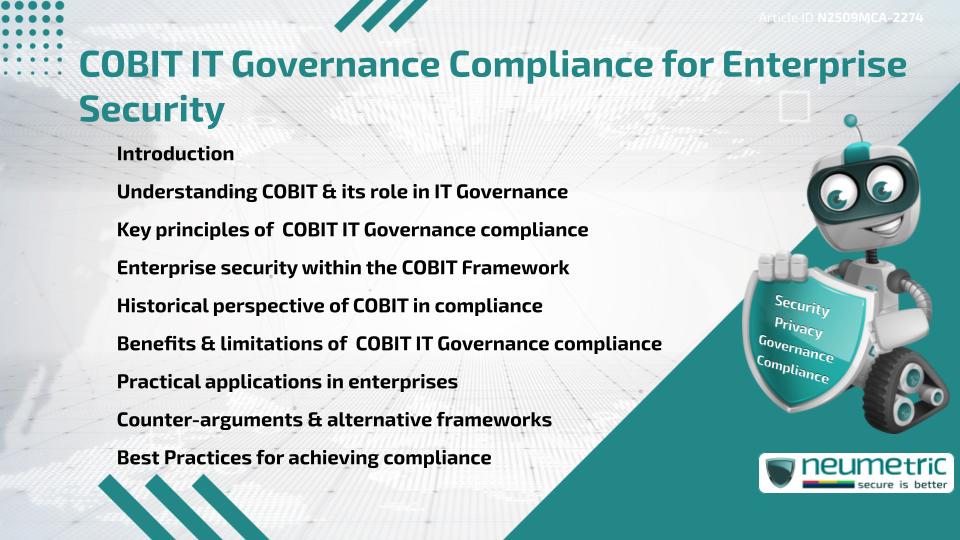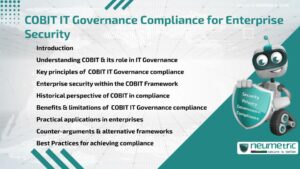Table of Contents
ToggleIntroduction
COBIT IT Governance compliance has become a cornerstone for enterprises that prioritise both Information Security & regulatory accountability. By aligning IT processes with business goals, COBIT ensures that Organisations maintain transparency, manage Risks effectively & safeguard data. Its Framework addresses key challenges in enterprise security, including access management, system integrity & Risk Mitigation. This article explores the principles of COBIT IT Governance compliance, its historical evolution, practical benefits, limitations & its vital role in strengthening enterprise security.
Understanding COBIT & its role in IT Governance
COBIT, which stands for Control Objectives for Information & Related Technologies, is a globally recognized Framework that guides enterprises in managing & governing IT. It provides structured Policies, procedures & practices to ensure that IT supports Business Objectives. Unlike ad hoc security practices, COBIT establishes measurable benchmarks that help Organisations remain compliant with both internal Policies & external regulations. More details on COBIT can be found on ISACA’s official page.
Key principles of COBIT IT Governance compliance
The foundation of COBIT IT Governance compliance rests on five key principles:
- Meeting Stakeholder needs
- Covering the enterprise end-to-end
- Applying a single integrated Framework
- Enabling a holistic approach
- Separating Governance from management
These principles ensure that IT processes align with business priorities, security Risks are assessed systematically & accountability is maintained across all levels of the Organisation.
Enterprise security within the COBIT Framework
Enterprise security is a critical component of COBIT, as it addresses confidentiality, integrity & availability of information. By integrating Governance controls, COBIT helps Organisations enforce access restrictions, conduct Vulnerability assessments & monitor system performance. For instance, COBIT’s alignment with standards such as NIST Cybersecurity Framework enhances its effectiveness in strengthening enterprise defenses.
Historical perspective of COBIT in compliance
First introduced in the 1990s by ISACA, COBIT was initially designed to address auditing & control needs. Over time, its scope expanded to include comprehensive IT Governance & Risk Management. Its integration with global regulations like GDPR & SOX demonstrates its adaptability & relevance across industries. Today, COBIT is recognized as a trusted tool for ensuring compliance in increasingly complex digital environments.
Benefits & limitations of COBIT IT Governance compliance
The benefits of COBIT IT Governance compliance include:
- Improved alignment of IT & business goals
- Enhanced Risk Management capabilities
- Stronger Regulatory Compliance
- Increased Stakeholder confidence
However, COBIT is not without limitations. Implementation can be resource-intensive & may require specialized expertise. Smaller Organisations might find the Framework too complex without proper customization. Additionally, strict adherence without flexibility can lead to bureaucratic overhead.
Practical applications in enterprises
Enterprises apply COBIT IT Governance compliance in various ways, such as:
- Conducting IT Risk Assessments
- Defining clear roles & responsibilities
- Establishing performance metrics
- Enforcing Continuous Monitoring & audits
By adopting these practices, Organisations strengthen enterprise security while maintaining operational efficiency.
Counter-arguments & alternative frameworks
While COBIT is widely respected, critics argue that frameworks like ISO/IEC 27001 or ITIL may offer more practical approaches for specific industries. Some suggest that combining multiple frameworks provides better results than relying solely on COBIT. Nevertheless, COBIT IT Governance compliance remains a preferred choice for Organisations seeking a broad, Governance-centered approach.
Best Practices for achieving compliance
To successfully achieve COBIT IT Governance compliance, enterprises should:
- Gain leadership buy-in & establish clear objectives
- Train Employees on Compliance Requirements
- Integrate COBIT with other security frameworks
- Perform regular Audits & updates
Following these Best Practices ensures that compliance is not just a checklist but a sustainable part of the organisation’s culture.
Conclusion
COBIT IT Governance compliance is a powerful tool for enterprises that aim to balance security, accountability & business performance. While it requires effort & resources, its structured approach provides long-term value in managing Risks & protecting information assets.
Takeaways
- COBIT ensures IT alignment with Business Objectives
- It enhances enterprise security by addressing confidentiality, integrity & availability
- Historical evolution highlights COBIT’s adaptability
- Benefits include improved compliance & Risk Management
- Limitations involve complexity & resource requirements
- Integration with other frameworks can strengthen outcomes
FAQ
What is COBIT IT Governance compliance?
COBIT IT Governance compliance refers to the process of applying COBIT’s principles & controls to align IT with business goals while ensuring regulatory adherence.
Why is COBIT important for enterprise security?
COBIT enhances enterprise security by enforcing Governance controls that address Risk Management, Data Protection & system accountability.
How does COBIT differ from ITIL?
While COBIT focuses on Governance & compliance, ITIL emphasizes service management. Both can be complementary in enterprise IT strategies.
Is COBIT IT Governance compliance mandatory?
COBIT itself is not mandatory, but many industries adopt it to meet legal & regulatory requirements effectively.
Can Small Businesses implement COBIT?
Yes, but Small Businesses may need to simplify COBIT’s Framework to suit their size & resources.
How does COBIT support regulatory requirements?
COBIT aligns with global regulations such as GDPR & SOX, helping Organisations demonstrate compliance through structured IT Governance.
What are the main challenges of implementing COBIT?
Challenges include resource demands, need for expertise & potential complexity in integrating COBIT with existing processes.
Need help for Security, Privacy, Governance & VAPT?
Neumetric provides organisations the necessary help to achieve their Cybersecurity, Compliance, Governance, Privacy, Certifications & Pentesting needs.
Organisations & Businesses, specifically those which provide SaaS & AI Solutions in the Fintech, BFSI & other regulated sectors, usually need a Cybersecurity Partner for meeting & maintaining the ongoing Security & Privacy needs & requirements of their Enterprise Clients & Privacy conscious Customers.
SOC 2, ISO 27001, ISO 42001, NIST, HIPAA, HECVAT, EU GDPR are some of the Frameworks that are served by Fusion – a SaaS, multimodular, multitenant, centralised, automated, Cybersecurity & Compliance Management system.
Neumetric also provides Expert Services for technical security which covers VAPT for Web Applications, APIs, iOS & Android Mobile Apps, Security Testing for AWS & other Cloud Environments & Cloud Infrastructure & other similar scopes.
Reach out to us by Email or filling out the Contact Form…





